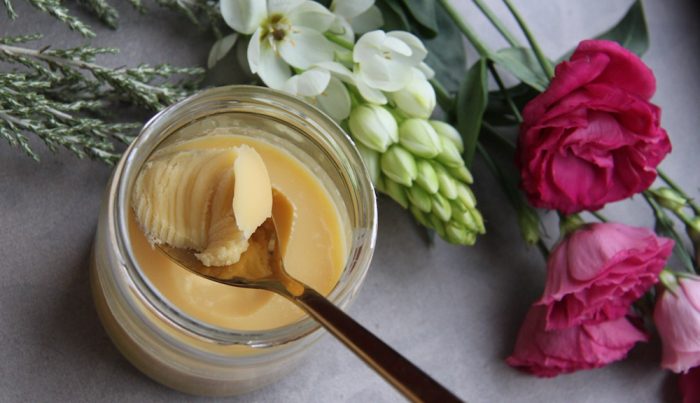Have you heard about the superpowers of ghee, the delicious, buttery Ayurvedic powerhouse?
Read on to know all the benefits you’re getting when you use clarified butter in your daily life (some may surprise you!).
According to Ayurveda, ghee has been used for thousands of years as the healthiest source of edible fat. Ayurveda considers ghee a rasayana, an anti-aging substance that builds and rejuvenates the body for longevity.
According to Ayurveda, ghee boosts digestive fire while improving absorption and assimilation. It builds ojas, the subtle essence of all tissues. Traditionally, it was used to improve memory and cognitive function while lubricating connective tissues, rendering the body more flexible. With regard to the three doshas (organizing or governing principles of the body), ghee pacifies vata and pitta and is acceptable for kapha in moderation. (Want to find out your dosha? Take the quiz here.)
Benefits of Ghee
- A fat that does not raise cholesterol levels
- Increases stem cells
- A bio-enhancer of other nutrients
- Extremely heat tolerant
- Highest food source of butyric acid
Ghee and Cholesterol
Ghee consists of 47.8 percent saturated fat, which has been linked to cardiovascular disease (CAD). Because of this link, some researchers suggest ghee, commonly consumed in India today, is the cause of their rising levels of CAD. But one study reports that ghee is actually rarely used in modern India, as it is too expensive. For the past two decades, cheaper polyunsaturated fatty acids (PUFAs) have replaced traditional use of ghee.
Prior to their use of PUFAs, ghee was the primary fat for both cooking and consumption. A couple generations ago, India was known for having low levels of CAD-related concerns. Today, Indians use a highly processed vegetable ghee called vanaspati, which is 40 percent trans fat, well known to increase risk of CAD.
Therefore, perhaps it is their movement away from ghee that is increasing cardiovascular risk. Numerous studies confirm consumption of ghee as high as 10 percent of the diet does not increase cholesterol levels nor incur oxidative damage.
Ghee: Highest Food Source of Butyric Acid
The name butter is derived from its most prevalent fatty acid, butyric acid. (The Latin word for butter is butyrum.) Ghee is made by boiling off water and milk solids from butter, leaving a purified butter that is the highest food source of butyric acid on the planet.
Butyric acid is so important to our overall health; we have numerous microbes, such as Clostridium butyricum, that literally manufacture butyric acid or “ghee” in the gut.
Benefits of Butyric Acid
>> Primary fuel for cells of the colon
>> Driver of gut immunity
>> Wards off bad bacteria
>> Boosts digestive strength
>> Supports healthy bowel movements
>> Balances blood sugar, weight, and hunger
>> Is the major food for the gut microbiome
>> Boosts stem cells
Ghee’s Butryic Acid Boosts Stem Cells
Stem cells build new tissue, repair broken parts, and fight aging and degeneration. In Ayurveda, agents that boost stem cells are known as rasayanas, and ghee is known as a longevity rasayana. Perhaps this is because butyric acid has been shown to increase production mesenchymal stem cells from the bone marrow, one of the body’s major sources of stem cell production.
Another study shows that butyric acid (a short-chain fatty acid) increases adipose-derived stem cells (ADSCs) beneath the skin. In this study, butyric acid was shown to enhance stem cell adipogenesis (production of new fat cells). It had an integral interaction between the skin microbiome.
Ghee is Heat Tolerant
In a study to determine if ghee was heat tolerant, ghee heated to 120°F was compared to room temperature to determine if either raised cholesterol levels. Neither group saw increased cholesterol levels.
Ghee as a Bio-Enhancer
Ghee is used to prepare many Ayurvedic herbal formulations. Ghee is well-known as a carrier of other nutrients, increasing their bioavailability and effectiveness. In Ayurveda, this is known as an anupaan, or vehicle.
An anupaan is therefore a food given with an herb to increase its effect. It is for this reason we add a small amount of black pepper to turmeric, boosting its absorption and potency. Combining foods and herbs to increase their action is called yogavahi in Ayurveda.
Ghee Takeaways
Along with olive oil, ghee is my favorite fat for cooking, oleation during cleanses, and combining with herbs to enhance their potency.
Do you use ghee in your daily life? What have you found?












Read 0 comments and reply